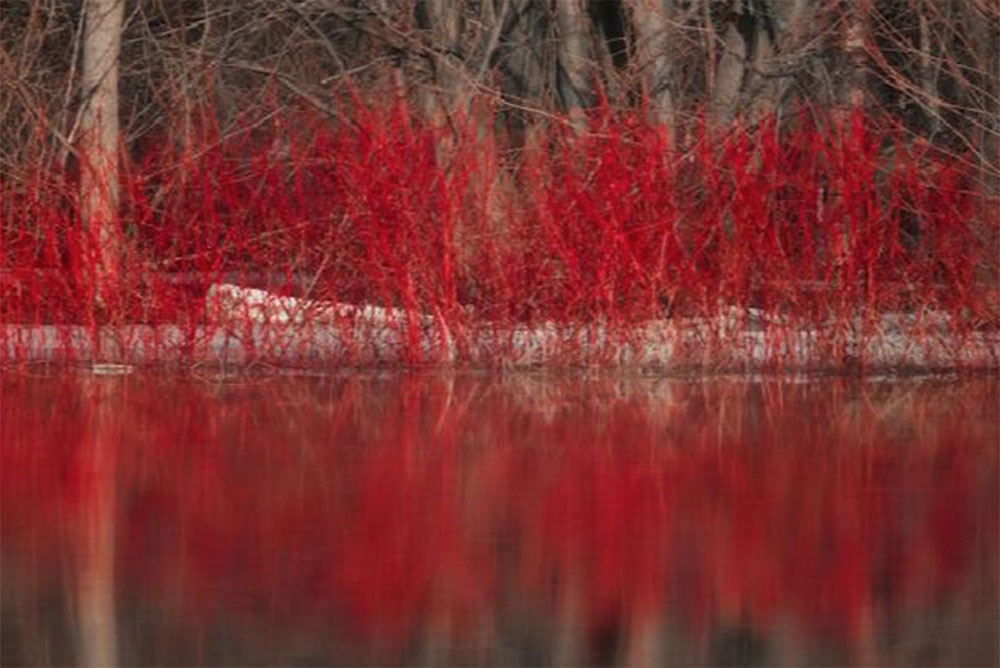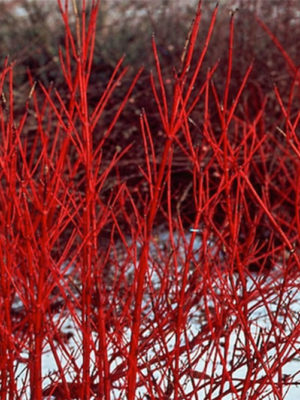
By Stephanie Cavanaugh
WHEN WASHINGTON GARDENER Magazine posted an item about red-twig dogwood a few weeks ago on Facebook, it opened up quite the box of thoughts.
First of all, I’d never heard of it. It is astonishing how little I know about so much.
This is not the dogwood we’re all familiar with, graceful trees with branches that bear clusters of flowers each spring in shades of red, pink, and white. This is a devil-may-care native shrub, with flaming red canes that can shoot up every which way, growing seven or eight feet in a single season and sporting abundant white blooms.
They’re also simple to propagate. Kathy Jentz, the editor and publisher of the award-winning publication, said you simply take a nice long cane and stick it in the soil to the third node, or pimple, or whatever you want to call the little knobs on the branches, and Lo! It will grow.

If you don’t have a neighbor with this dazzling plant, you can find one at places like Lowe’s, above, or a garden center. / Spring Hill Nurseries image.
This is the kind of plant I’m always taken with. No fancy splicing and fussing and misting and god knows what. You take my favorite gardening tool, a chopstick, stick it in the soil to make a nice hole, insert your twig, and off you go.
Most delightful, when the leaves drop in the fall, the branches retain their blazing red hue through the winter and on again into spring.
If you have a sunny spot, red-twig dogwood is handy as an accent plant and makes a gorgeous hedge, particularly when planted in front of an evergreen background. (There’s also a yellow variety, if that better floats your boat.)
I’ve seen only a single patch of it in my Capitol Hill neighborhood, in a garden in front of Trader Joe’s. Its fiery branches form a brilliant accent among other native plants.
A frustrating series of calls followed, with small local garden centers having none—and no guarantee when any would be arriving. So, I’m thinking, dark of night, mask in place, secateurs in hand . . .
But first I contacted Kathy, who kindly offered me a plant from her Silver Spring, Maryland, home. “Bring a bucket,” she said.
I also brought My Prince, and his little white truck. You never know, you know.
Kathy’s place looks less like a garden than a horticultural experiment, with hundreds of plants underfoot, in pots, and in containers waiting to be planted somewhere. She clipped a few five-foot canes from her largest dogwood, a good 8-feet tall—it’s about 10 years old, she said, and most of the branches are brown, not red.
“I cut a lot of the red ones for an arrangement this winter,” she told me. “The red only appears on new growth.” There’s another happy reason to grow them, they’d be gorgeous in a display mid-winter. Plus, you can plant the stems later.
Handing My Prince a shovel, she pointed out a nice little plant, which came unearthed along with a deep tangle of roots. These, she said, will run underground and sprout new plants. “You have to keep an eye on it,” she said.
The plant went in the bucket, and the shovel was replaced with long-handled clippers, which My Prince used to trim ivy that had grown on her house wall, threatening the gutters, while I directed him to watch his step. Our thanks for the plants and the lesson.
Kathy will soon be pruning the big plant low to the ground, and new red canes will quickly grow and soon be smothered in small white flowers for a spring display.
No doubt their availability at large garden centers will also grow as the weeks roll along, but keep an eye peeled in your neighborhood and maybe you’ll luck into a cutting too.

Well, there’s a plant no one is going to see
red over! Your column so often makes me desperate for a garden.